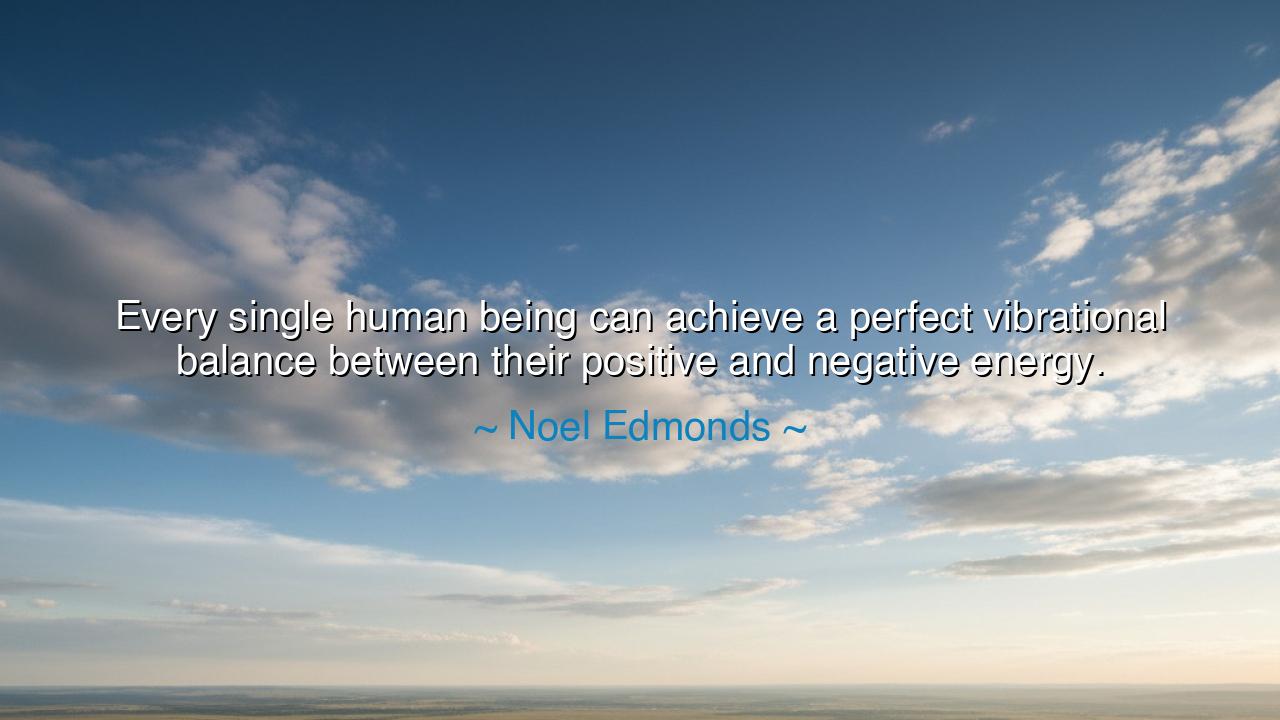
Every single human being can achieve a perfect vibrational
Every single human being can achieve a perfect vibrational balance between their positive and negative energy.






Hear the words of Noel Edmonds, who declared with conviction: “Every single human being can achieve a perfect vibrational balance between their positive and negative energy.” This is no idle saying, but a call to harmony, a reminder that within every heart there are forces of light and shadow, of creation and destruction, of joy and sorrow. To live well is not to deny the negative energy, nor to cling only to the positive, but to bring both into rhythm, so that the soul becomes like a well-tuned instrument, resonating with strength and peace.
For in truth, all of existence is woven of dualities. The night gives meaning to the day, silence deepens the song, and even sorrow sharpens the taste of joy. If one clings only to the bright, one becomes shallow; if one is drowned only in darkness, one becomes lost. Edmonds speaks of the vibrational balance that unites these forces, transforming them from enemies into partners, so that the soul may walk steady in a world of storms.
History offers many who bore this wisdom. Think of Marcus Aurelius, the philosopher-emperor of Rome. Surrounded by war, betrayal, and plague, he did not deny the negative energy that pressed upon him. Instead, he learned to balance it with inner calm, writing meditations that still guide seekers today. His greatness was not in escaping hardship but in finding equilibrium within it, turning turmoil into harmony through discipline of the mind.
So too in the life of Mahatma Gandhi, who faced hatred, oppression, and violence. He did not meet darkness with darkness. Instead, he transformed it, balancing his anger with compassion, his grief with hope. His path of nonviolent resistance revealed the power of perfect vibrational balance, where neither rage nor passivity ruled, but where the harmony of inner strength moved millions.
The meaning of Edmonds’ words is this: no human being is condemned to chaos. Within each of us lies the power to shape our energies, to bring balance between our doubts and our dreams, our fears and our faith. The struggle is constant, for life will always shake us with new trials. Yet even so, the possibility of harmony remains, if we choose to seek it. This is the hidden power of the human spirit: the ability to turn turbulence into music.
The lesson, then, is clear. Do not flee from your negative energy, for it has lessons to teach. Anger can sharpen justice, grief can deepen love, failure can awaken perseverance. Yet do not let these consume you. Balance them with gratitude, joy, and faith. Strive always to be in rhythm, neither silencing one side nor letting it drown out the other, but weaving both into a song that sustains you.
Practical wisdom calls us to three acts: first, practice awareness of your inner state—pause each day to ask, “Am I in balance?” Second, cultivate practices that restore harmony—through meditation, prayer, music, or movement. Third, seek relationships that nurture equilibrium, for the energies of others shape your own. In this way, step by step, you will draw nearer to the perfect vibrational balance that Edmonds speaks of.
So let it be remembered: every single being carries within them the potential for harmony. The light and the dark, the joy and the sorrow, the positive and negative energy—all can be tuned into balance. Noel Edmonds’ words are a promise and a challenge: to master the art of equilibrium is to live not in fragments, but as a whole, radiant soul. And such a soul, steady and balanced, becomes a beacon to others, showing the world that peace is not found by fleeing from struggle, but by mastering it.






VHLe Viet Hoang
The idea is fascinating but somewhat abstract. How do we reconcile daily emotional fluctuations with the notion of a perfect balance? Is it realistic to maintain equilibrium at all times, or is it more about long-term trends in energy levels? I’d be interested in strategies or frameworks that guide someone toward balance, especially for people prone to mood swings, chronic stress, or emotional burnout. Are there cultural or historical references that support this idea?
LQViet Le Quoc
This makes me wonder about the universality of the claim. Are there exceptions, or is this something truly attainable for everyone regardless of life circumstances? How much of achieving this balance depends on inner effort versus external environment? I’d like to see examples of people who consciously cultivate this equilibrium and how it has affected their lives. Could it be tied to mindfulness practices, meditation, or other holistic approaches?
DTdinh thuy
I’m skeptical but curious—does this imply that someone who struggles with constant stress or anxiety hasn’t achieved their balance? What steps, if any, are suggested to consciously adjust our energy toward equilibrium? I’d also like to know if there are measurable benefits when someone achieves this so-called balance, or is it primarily a subjective feeling? Exploring the scientific versus spiritual interpretations could clarify a lot for me.
TBpahm thienn bao
I find this concept both inspiring and a little confusing. If everyone can achieve this balance, does that imply negativity is as necessary as positivity? How do we deal with extreme circumstances where negative energy feels overwhelming? I’d like to understand how this balance interacts with mental health or emotional well-being. Can it be applied practically in daily life, or is it more of a philosophical statement?
NNNgoc Nga
This idea is intriguing, but it raises questions about feasibility. How can one measure or even define ‘vibrational balance’ between positive and negative energy? Is this purely a spiritual concept, or does it have a psychological or physiological basis? I’m curious if there are practical techniques to achieve this balance, or if it’s more of an aspirational ideal. Could different cultural or personal interpretations affect how someone approaches this idea?